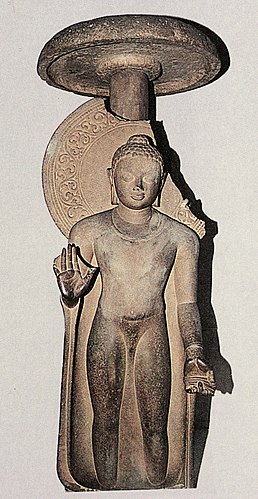| Translations of Chatra | |
|---|---|
| English | Umbrella |
| Sanskrit | Chatra |
| Pali | Chatta |
| Burmese | ထီး |
| Chinese | 伞/傘, 伞盖/傘蓋 (Pinyin: sǎn, sǎn gài) |
| Japanese | 傘, 傘蓋 (Rōmaji: san/kasa, sangai) |
| Khmer | ឆ័ត្រ |
| Korean | 산(傘), 산개(傘蓋) (RR: san, sangae) |
| Tibetan | རིནཆེན་གདུགས, གདུགས་ནི།[2] (rin chen gdugs, gdugs ni) |
| Thai | ฉัตร (RTGS: chat) |
| Glossary of Buddhism | |
The chatra (from Sanskrit: छत्र, meaning "umbrella")[a] is an auspicious symbol in Hinduism, Jainism and Buddhism.
The chatra in various traditions
[edit]According to Hindu mythology, it is the emblem of Varuna, also considered an embodiment of kingship. Chatra is also a deity, yidam and ishta-devata.[citation needed] In various Dharmic traditions it is an accoutrement of chakravartin.
A number of deities are depicted with chatra, including Ganesha (especially during Ganesh Chaturthi), Revanta, Surya, and Vishnu (in his Vamana avatar). The chatra is cordoned amongst the symbols that approach universality within the numerous octavalent suites or sets of Ashtamangala, e.g., in the Digambar Jain tradition, and the Vajrayana tradition.
In Dharmic tradition iconography, traditional Tibetan medicine thangkas and Ayurvedic diagrams, the chatra is uniformly represented as the Sahasrara.
In Vajrayana Buddhism, the umbrella or parasol is included in the 'Eight Auspicious Signs' or Ashtamangala.
The chatra shares a similar symbolic value to the baldachin, refer image of Vishvakarman.
In Burmese culture, the hti is considered regalia, and also crowns Burmese pagodas.
The Royal Nine-Tiered Umbrella is one part of the royal regalia of Thailand, and appears in connection with this role in the logo of Royal Umbrella rice.[3]
Gallery
[edit]-
Statue of a Bodhisattva crowned by a chatra, Mathura art
-
Umbrella with Eight Auspicious Motifs, c. 1st-2nd Century CE. Mathura Museum
-
Vishvakarman, Divine Architect of Vedas in a modern Hindu representation: note chatra
-
A modern statue of Chandragupta Maurya under a chatra
-
A closeup of Shwedagon Pagoda's hti
-
The Royal Nine-Tiered Umbrella (Nobapadol Mahasvetachatra) attached to a throne inside a hall in the Grand Palace, Bangkok. Only a crowned king can use an umbrella with nine-tiers, until then he must make do with only seven.
-
King Prajadhipok of Thailand signs a constitution within the Ananta Samakhom Hall. A large white chatra is seen nearby his throne.
-
A Saptapadol Mahasvetachatra (seven-tiered-white-umbrella) hangs over the urn of Princess Bejaratana Rajasuda of Thailand whilst the urn is being moved up to the Great Chariot of Victory, the seven-tiered umbrella denotes her rank as a royal princess.
-
Nobapadol Mahasvetachatra (nine-tiered-white-umbrella) over the funeral pyre of King Bhumibol Adulyadej.
-
Chatra kept in office of Tijara Jain temple, Rajasthan
-
A chatra symbol
See also
[edit]Notes
[edit]References
[edit]Footnotes
[edit]- ^ "Collections-Virtual Museum of Images and Sounds". vmis.in. American Institute of Indian Studies.
- ^ Sarat Chandra Das (1902). Tibetan-English Dictionary with Sanskrit Synonyms. Calcutta, India: Bengal Secretariat Book Depot, p.69
- ^ NTUC Fairprice, Royal Umbrella Fragrant Rice 5KG, 2017.
- ^ Osmund Bopearachchi, Emergence of Viṣṇu and Śiva Images in India: Numismatic and Sculptural Evidence, 2016.
Bibliography
[edit]- Dictionary of Hindu Lore and Legend (ISBN 0-500-51088-1) by Anna Dallapiccola
- General Buddhist Symbols
External links
[edit] Media related to Chatra at Wikimedia Commons
Media related to Chatra at Wikimedia Commons

![A chatra crowning Vāsudeva-Krishna on a coin of Agathocles of Bactria, c. 180 BCE.[4]](https://upload.wikimedia.org/wikipedia/commons/thumb/c/cb/Vasudeva_Krishna_on_a_coin_of_Agathocles_of_Bactria_circa_180_BCE.jpg/120px-Vasudeva_Krishna_on_a_coin_of_Agathocles_of_Bactria_circa_180_BCE.jpg)











Well, that’s interesting to know that Psilotum nudum are known as whisk ferns. Psilotum nudum is the commoner species of the two. While the P. flaccidum is a rare species and is found in the tropical islands. Both the species are usually epiphytic in habit and grow upon tree ferns. These species may also be terrestrial and grow in humus or in the crevices of the rocks.
View the detailed Guide of Psilotum nudum: Detailed Study Of Psilotum Nudum (Whisk Fern), Classification, Anatomy, Reproduction